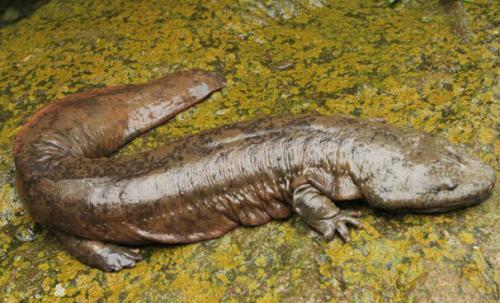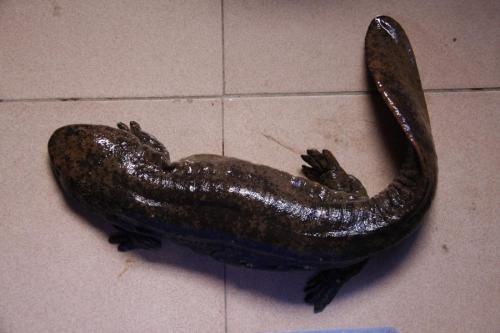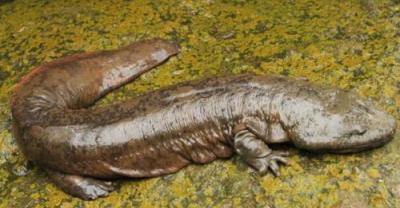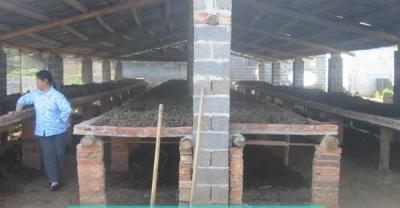Culture technology of baby fish and prospect of giant salamander culture
Baby fish, commonly known as giant salamander, is a national second-class key protected wild animals. Chinese giant salamander except Xinjiang, Xizang and Inner Mongolia. Except for Heilongjiang, Jilin, Liaoning and Taiwan, it is distributed in other provinces and autonomous regions, mainly in the mountains and rivers of the Yangtze River, the Yellow River and the tributaries of the middle and upper reaches of the Pearl River, especially in Sichuan, Hubei, Hunan, Guizhou, Shaanxi and other provinces. Giant salamander likes yin and is afraid of light, and its growth rate is slow. it takes 5 to 6 years for it to mature in wild conditions, weighs more than 500 grams, and at least 3 years to meet commercial specifications under artificial conditions. Moreover, it is difficult for giant salamander to breed artificially. Therefore, aquaculture is not common and is limited to a few farms in Jiangsu, Hubei, Guangdong and other places. However, in recent years, the culture of baby fish has received extensive attention, and it is a potential species of famous, special and excellent culture.

I. Design and construction of breeding grounds
According to the unique ecological habits of baby fish, the living habits and ecological environment suitable for the growth and development of baby fish should be considered in the design of culture pond.
(1) there are two kinds of culture ponds for baby fish culture, one is open-air culture pond, the other is civil air defense project and basement culture pond. Its structure is brick, cement, stone and concrete. The specific structural requirements are:
one. The requirements of the pool wall structure of the baby fish culture pond are: ① to cut off the water, so that it does not leak; ② is safe and firm, can withstand the pressure of the pool wall for four weeks and the pressure in the pool water, and the pool wall does not sink; ③ should have anti-escape facilities; ④ is cheap.
Doll fish culture pond walls are generally made of square stones, bricks or concrete, cement seams, and the pool walls should be smooth or pasted with cement paste.
The top of the pool wall should stick out 10 centimeters into him to prevent the baby fish from escaping.

2. The structure of the pond bottom the doll pond bottom is generally compacted with stones, with a thickness of 20cm to 30cm, then filled with small stone slag, and finally paved with concrete. In order to facilitate drainage, the bottom of the pool is tilted from all around to the center, with an inclination of about 2%, and then from the center to the outlet at one corner, with an inclination of about 1% to 1.5%.
3. The position of the inlet is based on the intake channel and opposite to the outlet is located at the corner of the pool. The water inlet should be higher than the pool wall, preferably 60 cm higher than the surface of the ground, and extend 20 cm into the pool. The water inlet material can be made of cement pipe or concrete, cast iron pipe and plastic pipe, no matter what material is used in the water inlet. Control facilities and filters must be installed. The control facility adopts a straight-through globe valve, and the size of the pipe diameter can be determined according to the amount of water needed at the mouth of all kinds of doll fish pond and the inlet pressure. The larval pool can be 100lu 300mm and the adult pool 300mm 500mm. The intake filter material should be made of stainless steel, and the same item should be determined according to the size of the doll fish pond.
(2) the construction of baby fish adult culture pond is an important environmental condition of baby fish culture and a key period in the stage of commercial culture of baby fish. In the adult stage, the resistance and adaptability of dollfish increased, while absconding and the law of the jungle also reached a peak. Therefore, adults are required according to their physiological characteristics at this stage. More than 5 are built so that they can be cultured separately according to individual size.
According to the actual situation in various places, the adult pool can be built indoors or in civil air defense projects, or outside. The area of the pool can reach 100 to 2000 square meters. The artificial Radian or cave area accounts for 2 × 3 of the adult pool area, and the Radian or cave size depends on the size of the adult tree. Outdoor pool construction, in addition to indoor adult requirements and facilities, shading facilities must be installed. Shade can be installed in all places according to the actual situation, requiring shade at the top and all around the pool.
2. Adult culture
Successful experience and technology have been obtained in adult culture in China, and the main culture methods are outdoor culture, basement, civil air defense engineering culture and industrial temperature control culture that we have developed. To sum up, it is mainly divided into still water culture and running water culture.

Natural baby fish is based on bait in the natural environment, so it grows slowly and generally needs 5 years old to reach adult. Artificial breeding of baby fish is to create a good ecological environment and provide nutritious feed. Generally speaking, it takes only 2 to 3 years of age to reach the adult stage.
Baby fish has great economic development value because of its high nutritional value and medicinal value. Therefore, the breeding technology of baby fish will be the focus of competition in China's aquatic industry for a period of time in the future, and baby fish will also be the key species to be developed in the future.
(1) the culture method of baby fish can be chosen in various places according to the situation. The temperature control culture technology-- the factory three-dimensional culture method of baby fish, which has obtained the patent right for invention, is introduced below.
(2) Adult stocking
One. Preparation before stocking
The main results are as follows: (1) the maintenance and disinfection of adult pool is mainly to check the inlet and outlet pipe. Check whether the barrier net is damaged, check the filter pool, filter device and temperature control machine for failure, and carry out maintenance, check the adult pool to see if it is damaged, repair it in time, then disinfect the adult pool and release it after the medicine disappears.
(2) Adult disinfection mainly prevents water mold and bacterial diseases, and the disinfection methods and drugs are the same as those of larvae. When stocking, the water temperature of the adult culture pond should be the same as that of the larva pond.
(3) the quantity and specification of adults should be checked before stocking, so that they can be reared in ponds according to the grades of adults. In this way, adults of the same size are basically the same in feeding ability and intensity, and the growth rate is basically the same, which can avoid mutual cannibalism caused by mixed culture.
two。 Stocking density adult stocking density of baby fish should be determined according to local culture methods, technical levels and culture conditions. The stocking standards of different culture methods of adults are summarized in table 5-2.
III. Feed and feeding
Feed and feeding are the central links of the whole baby fish culture technology. The advantages and disadvantages of feeding and management work on the growth and development of adults. The occurrence of baby fish disease, the stability of water quality and the yield of adult survival rate are all closely related.
(-) Ecological and physiological habits of adults
1. The adults of living habits inhabit the dark springs of the Yinhe River in the natural environment, and the farmed ones live in artificial caves.
2. The adult diet is carnivorous, and the diet can be divided into two categories: fresh and frozen animals (but excessive fat content is not suitable) and artificial compound feed.
3, the determinants of adult growth and gonadal development at water temperature, the suitable range is 16-25 ℃, and the best range is 18-23 ℃.
4. Oxygen consumption is 20.28 mg / kg ha in daytime and 21.69 mg / kg ha in nighttime.
The suitable PH for adult 5.PH is 6.5-7.5.
6. The light adult is a backlight movement-one is photophobia, which requires a light intensity of 100,500 lux.
(2) Feed and feeding methods
1. The kind of feed baby fish is carnivorous, and its natural feed resources are very rich, mainly fish, shrimp, frog, shellfish, Loach, chicken and duck embryos, mutton, beef, rabbit meat, earthworms and so on. We have developed the artificial formula feed for baby fish. The feed coefficient of adults fed with natural diet is 3.5-6.3. The feed coefficient of adults fed with artificial formula feed was 2.8 ~ 3.6. Each place can decide the kind of bait according to the local feed resources.
2. In order to improve the breeding benefit of baby fish and reduce the feed cost, it is necessary to understand the digestion, absorption and utilization of nutrients in feed before feeding in order to determine the reasonable feeding. Rational feeding includes nutrition, growth, metabolism, physiology, ecological environment and other factors, such as feeding amount, feeding times, feeding methods and feeding principles.
The main results are as follows: (1) the feeding time and times of baby fish are vigorously digested and absorbed under the condition of suitable temperature, usually once every 2-3 days, and once every 5-7 days if the humidity is less than 10 ℃. Baby fish lie dormant during the day and eat at night, so the feeding time is 8: 10 p.m. every day in summer and 6-8 p.m. In winter.
(2) there are many factors affecting the feeding of baby fish, such as water temperature, dissolved oxygen, water quality, disease, feed variety, feed quality and so on. The feed requirement of baby fish can be calculated according to the number of adults in the pond and the daily feeding rate.
Atom W × E
In the formula, Amure-daily feed consumption
Wmuri-Baby Fish weight
Emure-feeding rate.
Water temperature is an important factor affecting the feeding of baby fish, because baby fish is a variable temperature animal, with the level of water temperature, the physiological metabolism of the body changes. In the range of suitable temperature, the feeding and growth of baby fish are positively correlated with the increase of water temperature. Generally, the food intake is more than 12 ℃, and the food intake is the largest and the growth is the fastest at 18-23 ℃. When the water temperature rises above 26 ℃, the food intake decreases, and when it is over 28 ℃, it enters "summer dormancy". Under the condition of suitable temperature and the same feed quality, dissolved oxygen and water quality play an important role. Therefore, the feeding amount of adults should be determined by combining various factors. after 10 years of research results, we have obtained a feeding standard under different water temperature conditions, which can be used for adult culture.
(3) the reasonable feeding method should be determined according to the biological and ecological habits of baby fish. In order to improve the feed utilization rate and reduce the feed cost, we must adhere to the four-fixed feeding method, that is, timing, positioning, quality and quantity.
① timing is according to the biological habits of baby fish feeding characteristics at night, but also according to the season, water temperature, water quality status appropriate advance or delay. The general feeding time is 10 pm in summer and 8 pm in winter.
② positioning to develop the feeding habit of baby fish can promote the concentrated feeding of baby fish. Group feeding can not only increase the appetite and food intake of baby fish, but also reduce the dispersion of feed and improve feed efficiency.
If ③ is artificial compound feed, it should be kept in a place of low temperature, dryness and no moisture, and the addition of feed additives for adults is also different due to different breeding purposes. In order to improve the utilization rate of protein in formula feed, oil should be added in feed preparation, such as fish oil, vegetable oil and so on. The amount of oil added varies with the water temperature. Generally, fish oil and corn oil are added 5% and 5% respectively when the water temperature is 18-23 ℃. When the water temperature is 14~l.7 ℃, the oil addition amount is 5%-6%. When the water temperature is below 12 ℃, no oil can be added. Natural bait is required to be fresh and clean, and spoiled bait must not be fed. Loach, maggot worms, crucian carp, chicken and duck embryos are the ideal feed for natural bait.
④ was given an appropriate amount of feed according to different factors such as feeding, digestion, individual growth, body size, water temperature, water quality and so on.
Aquaculture management
(1) the management of the adult pond after a period of time, the individual increases, the density increases relatively, and the baby fish disease also occurs. Therefore, the daily management is very important. The daily management of adult pool can be summed up as follows: first diligence, second morning, third look, and four precautions.
Yiqin: is to patrol the pool frequently. Patrol the pool three times a day, observe the situation after feeding in the morning, pay attention to the change of water temperature at noon, and observe the adult feeding condition in the evening.
Second morning: that is, early stocking and early feeding. Pay attention to whether you are feeding when the water temperature rises after the Spring Festival. if you do not eat, you should use heating to make adults eat as soon as possible.
The third look is to look at food intake, to see if there is a rush to eat or whether there is vomiting, and to see the water quality. The main way to look at food intake is to see whether adults are concentrated or scattered in the food market. To see if there is a rush to eat or whether there is a phenomenon of vomiting, in order to adjust the amount of feed. Water quality is mainly determined by whether the water quality is fresh and transparent, so that measures can be taken to improve the water quality.
Four defenses: heat prevention, disease prevention, escape prevention and waterproof change.
Heat prevention is one of the important tasks in adult pool management in summer. Due to the high water temperature in summer, adults are easy to die, so it is necessary to take heat prevention and cooling, which is beneficial to the growth of baby fish. Outdoor heat prevention is mainly to set up shade to make the light intensity low. The change of water is carried out late at night, which is beneficial for adults to "spend the summer".
Disease prevention is to prevent baby fish disease. It is necessary to pay attention to the feeding activities of baby fish at any time. If adults are found to be wandering alone, check and study the disease condition, adopt isolation and prevention measures, and treat them in time.
To prevent escape is to prevent adults from escaping, to often check the water entrance and exit, to strengthen management, and to prevent flight.
Waterproof change is to prevent the water quality from deteriorating.
The adult pond should not only do a good job of feeding management, but also carry out water quality management, adult disease prevention and control work.
Fifth, the prospect of giant salamander culture
(-) the present situation of baby fish culture
At present, China's baby fish aquaculture industry is still in its infancy, and most of the breeding is carried out in the laboratories of the institute. Due to the lack of research funds and the unique physiological and living habits of the animal, many attack projects and projects were aborted, and there were few farmers with a certain scale, which will take some time to help form a large-scale breeding situation.
(2) the ornamental value of baby fish
Baby fish has a colorful back, four fingers like hands, five toes like feet and a loud mouth, hence the name baby fish, which is one of the species with a long life span among amphibians, which can last as long as 50-60 years in captivity, and some live for more than 130 years in the wild, still fat and tender, so some people call it "birthday fish". As an ornamental animal, dollfish has always been loved by people, which can add novelty to parks, zoos and tourist areas.
(3) the scientific research value of baby fish
Baby fish is a relatively primitive species of amphibians that have changed from aquatic to terrestrial. It has a certain research value in the study of animal evolution and other scientific research and teaching.
(4) the medicinal value of baby fish.
According to the Compendium of Materia Medica, baby fish has special uses such as increasing appetite, tonifying overflow and treating deficiency, black hair and beauty, prolonging life, enhancing human immune function, cancer prevention and health, and so on. Its skin is a good medicine for treating gunshot wound, knife wound, burn, scald and other kinds of trauma. In particular, the treatment of facial burns without leaving scars is even more magical, which can be described as a panacea in the department of trauma.
(5) Edible value of baby fish
The meat of baby fish is white and tender, fat but not greasy, and is rich in nutrients. It is an advanced nourishing and health care treasure, known as "living ginseng" in the water. As early as the 1960s, it bought a large amount of foreign exchange for our country. If the full artificial culture is successful, a series of health care treasures can be reasonably developed, and its breeding prospect is very broad.
(6) looking at the prospect of culture from the difficulty of feeding and management techniques.
1. The living environment of baby fish requires fresh water with fresh water quality and large drop, and the water temperature is within 0-25 ℃, such as small rivers, mountain springs and groundwater. The environment should be quiet and the light should be dim. Baby fish is very resistant to disease, vitality and hunger tolerance is also very amazing.
2. The growth rate of baby fish is very fast, and it weighs more than 0.35 kg to reach sexual maturity. Baby fish lay eggs once a year, and the number of eggs laid varies with individual weight, generally ranging from 300 to 1500 eggs each time. Artificial culture must achieve the best ecological environment and comprehensive nutrition supply in order to achieve the best spawning effect.
3. At present, full artificial breeding is still in the process of studying and tackling key problems. Because the animal has special physiological habits and is extremely afraid of shock, artificial breeding often requires tedious procedures such as catching and injecting, so that the eggs of baby fish are digested and absorbed because of shock, and the success rate is very low. Further exploration and research is needed.
To sum up, with the continuous progress of artificial breeding technology of baby fish, it is of great significance and broad prospects to choose a good breeding site, artificially create ecological environment and vigorously develop artificial breeding.
- Prev

Culture technology sharing: bamboo rat culture technology
The best site for the construction of bamboo and rat houses is in the mountains with flat terrain, good ventilation, facing south and rich plant resources, so that mountain resources can be used effectively.
- Next

Culture technology: breeding and pest control of Chunjian
Spring Jian is often called authentic Sichuan orchid. Although there are famous products in Yunnan, Guizhou and Sichuan, Sichuan orchid is the most expensive. Chunjian is a monocotyledonous plant, belonging to Orchidaceae. It is 20-40% high.
Related
- On the eggshell is a badge full of pride. British Poultry Egg Market and Consumer observation
- British study: 72% of Britons are willing to buy native eggs raised by insects
- Guidelines for friendly egg production revised the increase of space in chicken sheds can not be forced to change feathers and lay eggs.
- Risk of delay in customs clearance Australia suspends lobster exports to China
- Pig semen-the Vector of virus Transmission (4)
- Pig semen-the Vector of virus Transmission (3)
- Five common causes of difficult control of classical swine fever in clinic and their countermeasures
- Foot-and-mouth disease is the most effective way to prevent it!
- PED is the number one killer of piglets and has to be guarded against in autumn and winter.
- What is "yellow fat pig"? Have you ever heard the pig collector talk about "yellow fat pig"?

